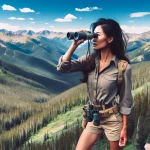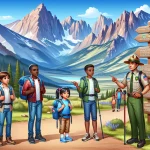From the soaring sandstone cliffs of Colorado National Monument to the ancestral Puebloan dwellings of Mesa Verde, these protected sites offer incredible scenery, outdoor adventures, and windows into the past. Their geological formations and archaeological discoveries reveal stories of bygone eras, while their hiking trails and river rapids thrill modern-day explorers. Whether you’re a history buff, nature lover, or adrenaline junkie, Colorado’s national monuments have something special awaiting you.
In This Article
TL;DR
- Colorado's national monuments highlight the state's natural diversity with breathtaking canyons, plateaus, and rock formations.
- Ancient Indigenous cultures like the Ancestral Puebloans and Fremont left behind archaeological sites that provide insights into Colorado's human history.
- Visitors can enjoy hiking, rafting, climbing, and other outdoor activities within the monuments' preserved landscapes.
Destination Overview
As a tourist destination, Colorado National Monuments showcase the dramatic intersection of natural wonders, cultural heritage, and boundless outdoor recreation throughout the state. The monuments reveal Colorado’s living history through geology and archaeology, from sheer red rock walls glowing in the sunset to centuries-old cliff dwellings perched high above the canyons below. Visitors can hike through petrified dunes in Florissant Fossil Beds National Monument or stand atop the precarious spires of the Canyon of the Ancients National Monument.
The more adventurous can take on Class V rapids along the Colorado River’s thundering course through ruby canyons lined with Ancestral Puebloan granaries. All around, you’ll find vibrant displays of Indigenous arts, Ute tribal events, and fossil-filled trails telling tales of eras long past. Those wanting to embrace Colorado’s spirit of exploration need look no further than its national monuments.
Local Experiences and Culture
Immersing yourself in the local culture brings Colorado’s national monuments to life. From Ute tribal celebrations to Fremont rock art tours, visitors can gain meaningful connections to the people who have been linked to these lands for millennia.
In nearby communities, diners can sample regional dishes like Colorado lamb or elk sausage while perusing galleries and markets filled with Hopi pottery, Zuni fetishes, and Ute beading. Annual cultural events like Mesa Verde’s pow-wows, Hovenweep National Monument‘s solstice gatherings, and Fruita’s Mike the Headless Chicken Festival offer visitors lively displays of community traditions.
Tourists support the preservation of living heritage by engaging with monument residents through cultural exchanges, tours of sites like Yucca House National Monument led by Indigenous guides, and homestays on the Ute Mountain Reservation. These experiences reveal the deep ties these communities retain to the ancestral lands they still inhabit.
Historical Significance
The Colorado Plateau holds remnants of ancient peoples that continue to shape views of early American history. Within the monuments’ sandstone alcoves, masonry towers, and chipped boulders lie traces of the Fremont, Ancestral Puebloan, Ute, and earlier Paleo-Indian cultures. Sites like the Painted Hand Pueblo and Lowry Ruin provide glimpses into the Fremont people who inhabited the region a thousand years ago.
Centuries-old sites like Cliff Palace and Balcony House showcase the architectural and agricultural mastery of Ancestral Puebloan groups like the Mesa Verde, while modern-day Utes keep their cultural history alive. Archaeological research utilizes new technologies like LIDAR scanning to reveal even more dwellings and artifacts left behind by these ancient Coloradoans, challenging previous assumptions about America’s earliest civilizations.
By protecting this cultural record etched into the canyons’ walls, these monuments offer travelers an unbroken link to the past.
Outdoor Adventures
From hiking through slot canyons to rafting the Colorado River to snowboarding the Uncompahgre Plateau, the national monuments deliver big thrills with their protected backdrops. Adrenaline junkies can find Class V rapids cutting through Black Canyon of the Gunnison or mountain bike slickrock trails winding through McInnis Canyons. Families can opt for leisurely hikes around Yucca House National Monument or fishing along the Gunnison River Gorge.
Whitewater rafters won’t want to miss Browns Canyon National Monument, where they can traverse the rapids of the Arkansas River. If astronomy piques your interest, Chimney Rock National Monument near Pagosa Springs should be on your list. Every 18.9 years, there’s a “lunar standstill” you can view from the Great House Pueblo when the moon rises perfectly between rocks. Granted, it takes some skilled planning to time your visit just right!
When winter arrives, cross-country skiers and snowshoers discover a serene wilderness cloaked in snow amid the towering spires of Canyons of the Ancients National Monument. Or they can head into the Continental Divide backcountry to visit Camp Hale National Monument. As the seasons shift, the monuments reveal new facets of their natural splendor, inviting return trips to experience more of Colorado’s treasures.
With trails and terrain to challenge and delight all, these sites make adventure irresistible.
Conservation Efforts
Conservation organizations like the National Park Service, Bureau of Land Management, and Nature Conservancy help preserve Colorado’s natural and cultural heritage by protecting these sites. Strategies like limiting visitor numbers, closing sensitive areas seasonally, and restricting motorized access safeguard fragile ecosystems and archaeological resources.
Tourists can do their part through responsible practices – staying on marked trails, packing out all trash, observing wildlife from afar, avoiding trailside artifacts, and supporting local eco-tourism businesses. Beyond the monuments, water conservation along the Colorado River basin and wilderness area protections across the Western Slope aim to conserve the broader landscapes that nurture these sites.
Ongoing stewardship ensures future generations can continue exploring Colorado’s vibrant national monuments.
Indigenous Heritage
From the ancient Puebloan great houses of Mesa Verde to Ute tribal celebrations in Towaoc, the national monuments safeguard lands holding deep meaning for Indigenous peoples past and present. Centuries before becoming protected sites, these canyons and mesas were home to Ancestral Puebloan communities like the Cliff Dwellers.
Today, the monuments work closely with tribal historic preservation offices to respectfully manage areas containing ancestral sites and artifacts. Beyond physical sites, intangible heritage also lives on through Ute language programs, Puebloan agricultural practices, and oral histories recounting generations of connection to these places.
By elevating Indigenous voices in interpretation and collaborating on education initiatives, the monuments cultivate opportunities for visitors to engage with enduring Native American legacies.
Geological Wonders
A spectrum of awe-inspiring landforms fills the national monuments, showcasing Colorado’s geological diversity. At the Colorado National Monument near Grand Junction, the forces of erosion have carved plunging canyons, towering monoliths, and vast plateaus from uplifted rock layers. You can hike along Monument Canyon Trail or take Canyon Rim Trail to Window Rock. If hiking’s not your thing, drive Rim Rock Road to see the amazing sights without having to leave your car.
To the south, the Black Canyon of the Gunnison National Park has been hollowed out over eons by the Gunnison River to reveal sheer cliffs splitting the terrain.
Massive dune fields turned to stone reveal ripples and dunes frozen in time at the Florissant Fossil Beds National Monument near Colorado Springs. From the alien hoodoos of McInnis Canyons to the dramatic gorge spanned by the National Bridge, the monuments exhibit the power of water, wind, and time to shape wondrous features from solid stone.
Geology tours, fossil digs, and special events like Colorado National Monument Canyon and Crater Days invite visitors to uncover the stories written in stone across the monuments.
Architectural and Archaeological Discoveries
Cliff dwellings, pueblos, petroglyphs, and artifacts within the national monuments provide archaeologists insightful glimpses into ancient peoples. The well-preserved multistory dwellings of Mesa Verde’s Cliff Palace and the intricate celestial calendar encoded at Hovenweep National Monument’s Square Tower Group reflect the architectural and astronomical feats of ancestral Puebloan builders.
Recent excavations using aerial mapping and 3D scans have revealed previously unknown structures like the Long House at Canyons of the Ancients National Monument. Portable technologies allow archaeologists to analyze artifacts on-site and recreate sites digitally to understand how they once operated. Isotopic studies, tree-ring dating, and DNA analysis of human remains uncover hidden details about the lives of those who dwelled in these canyons long ago.
As research continues, discoveries made within Colorado’s monuments rewrite our understanding of early American civilizations.
FAQ
How can I visit ancestral Puebloan cliff dwellings respectfully?
Follow posted guidelines, stay behind barriers, avoid touching walls or artifacts, and be mindful that these are sacred sites for living cultures. Purchase tickets and tours from the monument itself to support preservation.
Where can I see dinosaur fossils in the monuments?
Head to Dinosaur National Monument to see hundreds of Jurassic fossils embedded along the canyon walls, or visit the Fruita Paleontological Area to see real dinosaur bones and ancient mammal fossils.
What rivers can I go rafting and fishing in?
The Colorado and Gunnison Rivers offer epic whitewater rafting through Black Canyon and Curecanti National Recreation Area. Calmer fishing waters flow through the Gunnison Gorge and McInnis Canyons.
How can I explore the monuments in winter?
Snowshoeing and cross-country skiing trails wind through Colorado National Monument and Canyons of the Ancients National Monument. Mesa Verde offers year-round ranger-led tours of cliff dwellings.
What is the best way to experience Ute tribal culture?
Attend pow-wows like the Southern Ute Bear Dance or Ute Mountain Ute’s Sun Dance. Book Ute-led tours of sacred sites like Ute Mountain Tribal Park or join a workshop on Indigenous arts like beading. Stay mindful and respect customs.






